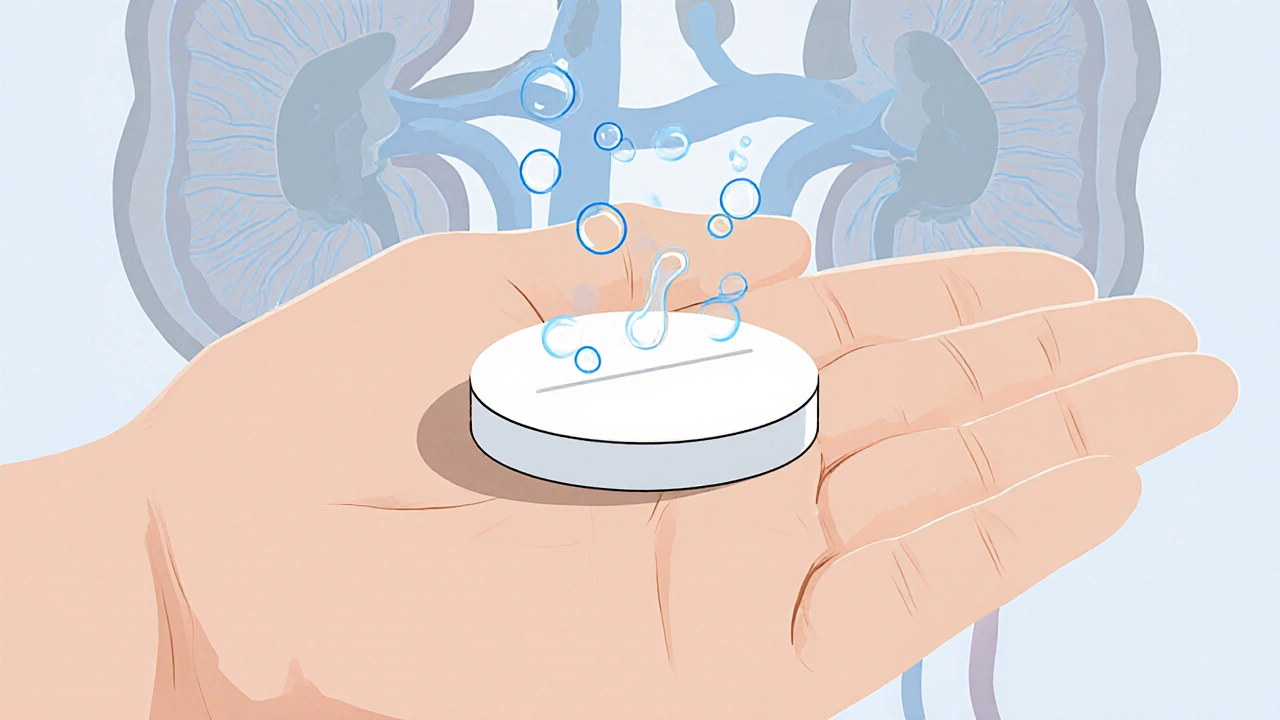
Florinef isn’t a drug you hear about every day. But for people with rare hormonal conditions, it’s not just medication-it’s life support. If you’ve been told you need Florinef, you’re probably wondering: what is this pill actually doing in my body? And why does it matter so much?
What Florinef Actually Is
Florinef is the brand name for fludrocortisone, a synthetic version of a hormone your body naturally makes: aldosterone. Aldosterone is made by your adrenal glands and tells your kidneys to hold onto sodium and push out potassium. That sounds simple, but it’s one of the most important jobs your body does to keep your blood pressure steady and your fluid balance in check.
When your adrenals don’t make enough aldosterone-like in Addison’s disease or certain forms of congenital adrenal hyperplasia-your body starts losing salt through urine. You feel dizzy when you stand up, your blood pressure drops, and you get weak. That’s where Florinef comes in. It replaces what your body can’t make on its own.
It’s not a steroid like prednisone or hydrocortisone, even though it’s in the same family. Those drugs mainly fight inflammation. Florinef doesn’t. It’s purely a salt-retaining hormone replacement. You can’t use it for arthritis or asthma. It won’t help with allergies. It only works if your problem is low aldosterone.
How Florinef Works in Your Body
When you take Florinef, it travels through your bloodstream and binds to mineralocorticoid receptors in your kidneys. Those receptors are like tiny switches. When fludrocortisone flips them on, your kidneys start reabsorbing sodium instead of flushing it out. Water follows sodium, so your blood volume goes up. That raises your blood pressure. At the same time, your kidneys dump out more potassium and hydrogen ions.
This isn’t just about feeling less dizzy. Low blood pressure from salt loss can cause fainting, confusion, and even kidney stress over time. Florinef helps prevent that. People who take it regularly report being able to stand in line at the grocery store without needing to sit down. They can walk the dog without getting winded. These aren’t minor improvements-they’re life-changing.
But here’s the catch: Florinef doesn’t work instantly. It takes a few days to build up in your system. And if you stop taking it suddenly, your body can crash. That’s why doctors never tell you to quit cold turkey.
Who Prescribes Florinef-and Why
Most people who take Florinef have one of two conditions:
- Addison’s disease (primary adrenal insufficiency): Your adrenal glands are damaged and can’t produce cortisol or aldosterone. Florinef replaces the aldosterone part. Cortisol is replaced with hydrocortisone or prednisone.
- Orthostatic hypotension from autonomic failure: This happens in conditions like Parkinson’s, diabetes-related nerve damage, or pure autonomic failure. Your body doesn’t tighten blood vessels properly when you stand. Florinef helps by increasing blood volume so your pressure doesn’t plummet.
Some kids with congenital adrenal hyperplasia (CAH) also take it. In certain forms of CAH, the body makes too much of one hormone and not enough of another-like aldosterone. Florinef fills that gap.
It’s not used for everyday low blood pressure. If you’re just a little lightheaded when you stand up, Florinef isn’t the answer. Doctors only prescribe it when lab tests show low aldosterone, high renin, and low sodium levels. No guesswork. No trial and error.

Dosage and How to Take It
Most adults start with 0.1 mg once a day. That’s one small white pill. Some people need 0.2 mg. A few need up to 0.3 mg, but that’s rare. Your doctor will adjust based on your blood pressure, sodium levels, and how you feel.
Take it in the morning. It can make you restless if you take it late. Don’t skip doses. If you forget one, take it as soon as you remember-but never double up. Missing doses can cause your blood pressure to drop fast, especially if you’re active or in hot weather.
Florinef is usually taken with food. It doesn’t irritate your stomach, but food helps your body absorb it more consistently. And yes, you’ll need to monitor your salt intake. Most people on Florinef need to eat more salt than the average person. That’s not a suggestion-it’s medical advice. A teaspoon of salt in your water or on your food every day isn’t unusual.
Side Effects You Need to Watch For
Florinef is generally safe when used correctly. But it’s not harmless. Because it makes your body hold onto sodium and water, you can get too much fluid. That leads to:
- Swelling in your ankles or feet
- Rapid weight gain (more than 2 kg in a week)
- High blood pressure (especially when lying down)
- Headaches or blurred vision
Too much potassium loss can cause muscle cramps, weakness, or irregular heartbeat. That’s why your doctor will check your blood potassium and sodium levels every few months. If your potassium drops too low, they might give you a potassium supplement or switch you to a different salt-retaining drug.
Long-term use can also lead to fluid overload, which strains your heart. That’s why you can’t just take Florinef forever without monitoring. It’s not a lifelong pill for everyone. Some people only need it temporarily after surgery or during an illness.

What Florinef Doesn’t Do
Many people assume Florinef is a general “energy booster” or “blood pressure fix.” It’s not. It won’t help if you’re tired from poor sleep or stress. It won’t cure chronic fatigue syndrome. It won’t improve your mood if you’re depressed.
And it doesn’t replace cortisol. If you have Addison’s disease and only take Florinef, you’re in danger. You still need hydrocortisone or another glucocorticoid. Florinef alone can kill you if you get sick or injured and your body can’t respond to stress.
It’s also not for pregnant women unless absolutely necessary. While it’s been used safely in some pregnancies, there’s limited data. Doctors weigh the risks carefully.
Alternatives and What Comes Next
There aren’t many direct alternatives to Florinef. Most other drugs that retain salt-like midodrine or droxidopa-work differently. They tighten blood vessels instead of increasing fluid volume. Some people take both Florinef and midodrine if one isn’t enough.
There’s no new version of Florinef coming out. It’s been around since the 1950s. Generic fludrocortisone is cheap and widely available. There’s no reason to pay extra for the brand name unless you have a rare allergy to the fillers.
If Florinef doesn’t work for you, your doctor will look at other causes of low blood pressure: dehydration, heart problems, nerve damage, or even long COVID. Sometimes, the answer isn’t a pill-it’s compression stockings, more water, or changing how you stand up.
Real-Life Impact
I’ve talked to people who’ve been on Florinef for 20 years. One woman in Wellington told me she used to collapse every time she stood up after having a baby. She couldn’t care for her kids. After starting Florinef, she walked her daughter to school for the first time in months. Another man in Christchurch, diagnosed with autonomic failure, went from using a wheelchair to hiking in the Southern Alps.
These aren’t miracles. They’re science. Florinef doesn’t cure the underlying disease. But it fixes the part that’s breaking. And for many, that’s enough to get their life back.
If you’re on Florinef, you’re not alone. But you need to be informed. Take it as prescribed. Monitor your weight and blood pressure. Talk to your doctor if you feel off. And never stop it without help.
Can Florinef cause high blood pressure?
Yes, if you take too much or your body holds onto too much fluid. Florinef raises blood pressure by increasing blood volume. If your pressure goes above 140/90 when lying down, or you gain more than 2 kg in a week, you may be getting too much. Your doctor will check your sodium, potassium, and blood pressure regularly to avoid this.
Do I need to eat more salt if I take Florinef?
Usually, yes. Florinef helps your body keep salt, but many people still lose more than they should. Adding 1-2 teaspoons of salt per day-through food or water-is common. Some doctors recommend a salt tablet if you’re very active or in hot weather. Don’t guess your needs-ask your doctor for a target.
Can I stop Florinef if I feel better?
No. Stopping suddenly can cause adrenal crisis, especially if you have Addison’s disease. Even if you feel fine, your body still needs the hormone replacement. Your doctor will slowly reduce the dose only if your condition improves-which is rare. Never adjust your dose on your own.
Is Florinef the same as hydrocortisone?
No. Hydrocortisone replaces cortisol, which helps your body handle stress, control blood sugar, and reduce inflammation. Florinef replaces aldosterone, which controls salt and water balance. People with Addison’s disease need both. Taking one without the other is dangerous.
How long does it take for Florinef to start working?
You might notice less dizziness in 2-3 days, but full effects take 1-2 weeks. Blood pressure and sodium levels usually stabilize after about 10 days. Don’t expect instant results. If you don’t feel better after two weeks, talk to your doctor-it might mean your dose is too low or there’s another issue.
Can Florinef be used for long-term treatment?
Yes, for conditions like Addison’s disease or chronic autonomic failure, Florinef is often needed for life. With regular monitoring of blood pressure, electrolytes, and weight, long-term use is safe. The biggest risk isn’t the drug itself-it’s forgetting to take it or not getting enough salt. Consistency matters more than the dose.




1 Comments
Florinef saved my life after my Addison’s diagnosis. I used to collapse just walking to the fridge. Now? I hike. I dance. I even went to a music festival 🎸💃. Don’t let anyone tell you it’s just a ‘salt pill’-it’s your body’s lifeline.